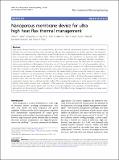| dc.contributor.author | Hanks, Daniel Frank | |
| dc.contributor.author | Lu, Zhengmao | |
| dc.contributor.author | Sircar, Jay | |
| dc.contributor.author | Salamon, Todd R. | |
| dc.contributor.author | Antao, Dion Savio | |
| dc.contributor.author | Bagnall, Kevin R. | |
| dc.contributor.author | Barabadi, Banafsheh | |
| dc.contributor.author | Wang, Evelyn | |
| dc.date.accessioned | 2019-01-14T15:47:52Z | |
| dc.date.available | 2019-01-14T15:47:52Z | |
| dc.date.issued | 2018-02 | |
| dc.date.submitted | 2018-01 | |
| dc.identifier.issn | 2055-7434 | |
| dc.identifier.uri | http://hdl.handle.net/1721.1/120022 | |
| dc.description.abstract | High power density electronics are severely limited by current thermal management solutions which are unable to dissipate the necessary heat fl ux while maintaining safe junction temperatures for reliable operation. We designed, fabricated, and experimentally characterized a micro fl uidic device for ultra-high heat fl ux dissipation using evaporation from a nanoporous silicon membrane. With ~100 nm diameter pores, the membrane can generate high capillary pressure even with low surface tension fl uids such as pentane and R245fa. The suspended ultra-thin membrane structure facilitates ef fi cient liquid transport with minimal viscous pressure losses. We fabricated the membrane in silicon using interference lithography and reactive ion etching and then bonded it to a high permeability silicon microchannel array to create a biporous wick which achieves high capillary pressure with enhanced permeability. The back side consisted of a thin fi lm platinum heater and resistive temperature sensors to emulate the heat dissipation in transistors and measure the temperature, respectively. We experimentally characterized the devices in pure vapor- ambient conditions in an environmental chamber. Accordingly, we demonstrated heat fl uxes of 665 ± 74 W/cm² using pentane over an area of 0.172 mm × 10 mm with a temperature rise of 28.5 ± 1.8 K from the heated substrate to ambient vapor. This heat flux, which is normalized by the evaporation area, is the highest reported to date in the pure evaporation regime, that is, without nucleate boiling. The experimental results are in good agreement with a high fi delity model which captures heat conduction in the suspended membrane structure as well as non-equilibrium and sub-continuum effects at the liquid – vapor interface. This work suggests that evaporative membrane-based approaches can be promising towards realizing an ef fi cient, high fl ux thermal management strategy over large areas for high-performance electronics. | en_US |
| dc.description.sponsorship | United States. Defense Advanced Research Projects Agency. ICECool Fundamentals Program | en_US |
| dc.publisher | Springer Nature America, Inc | en_US |
| dc.relation.isversionof | http://dx.doi.org/10.1038/S41378-018-0004-7 | en_US |
| dc.rights | Creative Commons Attribution 4.0 International license | en_US |
| dc.rights.uri | https://creativecommons.org/licenses/by/4.0/ | en_US |
| dc.source | Nature | en_US |
| dc.title | Nanoporous membrane device for ultra high heat flux thermal management | en_US |
| dc.type | Article | en_US |
| dc.identifier.citation | Hanks, Daniel F., Zhengmao Lu, Jay Sircar, Todd R. Salamon, Dion S. Antao, Kevin R. Bagnall, Banafsheh Barabadi, and Evelyn N. Wang. “Nanoporous Membrane Device for Ultra High Heat Flux Thermal Management.” Microsystems & Nanoengineering 4, no. 1 (February 26, 2018). | en_US |
| dc.contributor.department | Lincoln Laboratory | en_US |
| dc.contributor.department | Massachusetts Institute of Technology. Department of Chemical Engineering | en_US |
| dc.contributor.department | Massachusetts Institute of Technology. Department of Mechanical Engineering | en_US |
| dc.contributor.department | Massachusetts Institute of Technology. Research Laboratory of Electronics | en_US |
| dc.contributor.mitauthor | Hanks, Daniel Frank | |
| dc.contributor.mitauthor | Lu, Zhengmao | |
| dc.contributor.mitauthor | Sircar, Jay | |
| dc.contributor.mitauthor | Salamon, Todd R. | |
| dc.contributor.mitauthor | Antao, Dion Savio | |
| dc.contributor.mitauthor | Bagnall, Kevin R. | |
| dc.contributor.mitauthor | Barabadi, Banafsheh | |
| dc.contributor.mitauthor | Wang, Evelyn | |
| dc.relation.journal | Microsystems & Nanoengineering | en_US |
| dc.eprint.version | Final published version | en_US |
| dc.type.uri | http://purl.org/eprint/type/JournalArticle | en_US |
| eprint.status | http://purl.org/eprint/status/PeerReviewed | en_US |
| dc.date.updated | 2019-01-10T17:23:01Z | |
| dspace.orderedauthors | Hanks, Daniel F.; Lu, Zhengmao; Sircar, Jay; Salamon, Todd R.; Antao, Dion S.; Bagnall, Kevin R.; Barabadi, Banafsheh; Wang, Evelyn N. | en_US |
| dspace.embargo.terms | N | en_US |
| dc.identifier.orcid | https://orcid.org/0000-0002-8974-756X | |
| dc.identifier.orcid | https://orcid.org/0000-0002-5938-717X | |
| dc.identifier.orcid | https://orcid.org/0000-0001-8643-9281 | |
| dc.identifier.orcid | https://orcid.org/0000-0003-4165-4732 | |
| dc.identifier.orcid | https://orcid.org/0000-0002-5042-4819 | |
| dc.identifier.orcid | https://orcid.org/0000-0003-0550-1739 | |
| dc.identifier.orcid | https://orcid.org/0000-0001-7045-1200 | |
| mit.license | PUBLISHER_CC | en_US |
